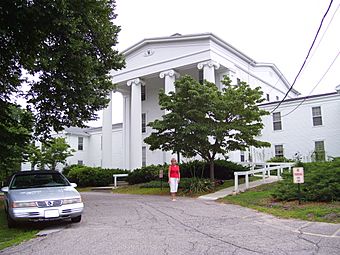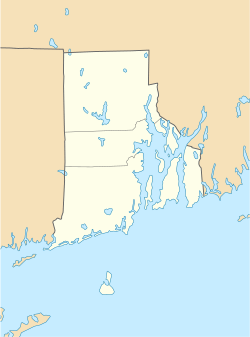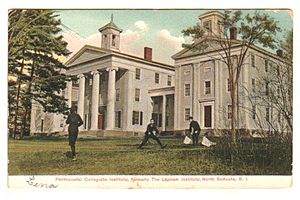Smithville Seminary facts for kids
|
Smithville Seminary
|
|
|
U.S. Historic district
Contributing property |
|

Smithville Seminary building in 2008
|
|
| Location | 29 Institute Ln., Scituate, Rhode Island |
|---|---|
| Built | 1839 |
| Architect | Russell Warren (architect) |
| Architectural style | Greek Revival |
| Part of | Smithville-North Scituate (ID79000003) |
| NRHP reference No. | 78003446 |
Quick facts for kids Significant dates |
|
| Added to NRHP | March 29, 1978 |
| Designated CP | August 29, 1979 |
The Smithville Seminary was a school founded in 1839. It was started by the Freewill Baptist church. The school was located in a place called Smithville-North Scituate, Rhode Island.
Later, in 1863, the school changed its name to the Lapham Institute. It closed its doors in 1876. After that, the same buildings were used by other schools. These included the Pentecostal Collegiate Institute and the Watchman Institute. Today, the buildings are apartments called Scituate Commons. In 1978, the site was added to the National Register of Historic Places. This means it's an important historical place.
The School Campus
The buildings for the school were built in 1839. They were on a small hill. The main building was large and had three stories. It also had big columns, like ancient Greek buildings. Two smaller buildings, called wings, were on each side.
Each wing had 33 rooms. They were connected to the main building by covered walkways. The main building held classrooms and offices. It also had apartments for staff and dining areas. On the second floor, there was a library. The third floor had a big room. This room might have been used as a chapel for worship.
The two wing buildings were dormitories. One was for boys and the other for girls. From the third-floor chapel, you could see Lake Moswansicut. This lake was two miles long.
A famous architect named Russell Warren designed these buildings. He was known for his Greek Revival style. This style was popular in New England at the time.
After the Lapham Institute closed, the campus was used again. The Pentecostal Collegiate Institute used it from 1902 to 1919. Then, the Watchman Institute took over in 1923. In the 1970s, the buildings were updated. They were turned into the apartments you see today.
School History
The Smithville Seminary was started in 1839. It was founded by the Rhode Island Association of Free Baptists. At that time, the Free Baptists already had two schools. One was in New Hampshire and the other in Maine. The Baptists in Rhode Island wanted their own school.
Reverend Hiram Brooks was asked to start the school. He raised $20,000 for the project. All of this money was used to build the school buildings. Unfortunately, no money was saved for an endowment. An endowment is a fund that helps a school pay its bills. This lack of savings caused money problems for the school. It could not make enough money from student fees alone.
The first principal was Reverend Hosea Quimby. He came from the Maine school to lead Smithville. Reverend Quimby worked hard for the school. He even bought the property when it faced money troubles. The school closed for a short time in 1854. It only had 20 students then. In 1845, it had more than 300 students from seven different states.
The school reopened the next year. Reverend Quimby rented the property to Samuel P. Coburn. Mr. Coburn became the new principal. That year, over 100 students enrolled again. In 1857, the property was sold to Reverend W. Colgrove. He ran the school for two more years. Then it closed again for three years.
In 1845, the school hosted the first Rhode Island Teachers Institute. This was led by Henry Barnard. The school began offering teacher training in 1867. This program received money from the government. But in 1871, the state stopped funding it. The state's Education Commissioner started a new teacher school.
In 1863, the school changed owners and its name. A former professor returned in 1861. He found many buildings in bad shape. The Free Baptist Association could not help. So, William Winsor asked Congressman Benedict Lapham for help. The school was then named the Lapham Institute after him.
The school also had ties to other colleges. It was connected to what is now Rhode Island College. It also had links to Bates College in Maine. Bates College was another Free Baptist school. The first principal of the Lapham Institute, Benjamin F. Hayes, became a professor at Bates. His replacement, Thomas L. Angell, also became a professor there.
George H. Ricker then led the school for seven years. He later went to Hillsdale College in Michigan. Arthur G. Moulton took over after him. He was a trustee at Bates College. Sadly, he died just over a year later. W.S. Stockbridge became the next principal. Under his leadership, the school finally closed in 1876.
William Winsor was the last person to give money to the Institute. When no one else stepped in, the school went bankrupt. It did not have an endowment to keep it going. In 1883, Mr. Winsor gave the library from the Lapham Institute to the Greenville Public Library.
Notable Alumni
Many important people went to this school. Here are a few:
- James Burrill Angell – He became the president of the University of Michigan and the University of Vermont.
- Thomas L. Angell – He was a professor at Bates College.
- Lewis Boss – He was an astronomer. He directed the Dudley Observatory.
- George T. Day – He was a pastor, writer, and professor.
- Henry Howard – He was the Governor of Rhode Island from 1873 to 1875.
- Oscar Lapham – He was a U.S. Congressman.





